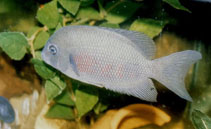http://www.fishbase.org/Summary/speciesSummary.php?genusname=Paretroplus&speciesname=dambabe ---> http://192.134.151.83/Summary/speciesSummary.php?genusname=Paretroplus&speciesname=dambabe
http://192.134.151.83/Summary/speciesSummary.php?genusname=Paretroplus&speciesname=dambabe ---> https://fishbase.mnhn.fr/Summary/speciesSummary.php?genusname=Paretroplus&speciesname=dambabe
https://fishbase.mnhn.fr/Summary/speciesSummary.php?genusname=Paretroplus&speciesname=dambabe ---> https://fishbase.mnhn.fr/summary/Paretroplus-dambabe.html
Paretroplus dambabe : fisheries

You can
sponsor
this page
Common name (e.g. trout)
Genus + Species (e.g. Gadus morhua)
-

-
About this page
-
Languages
-
User feedbacks
-
Citation
-
Uploads
-
Related species
-


 Upload your
photos
and
videos
Upload your
photos
and
videos
Pictures
|
Google image
 Paretroplus dambabe
Paretroplus dambabe
Picture by
Tourle, D.
Classification / Names
Common names
|
Synonyms
| Catalog of Fishes(
genus
,
species
) |
ITIS
|
CoL
|
WoRMS
|
Cloffa
Teleostei (teleosts) >
Cichliformes
(Cichlids, convict blennies) >
Cichlidae
(Cichlids) > Etroplinae
Etymology:
Paretroplus:
Name from the Greek 'para' meaning 'on the side of'; in taxonomy it is commonly used in generic names to express similarity or relatedness; in the present case it would mean 'next to
Etroplus
' (S.Kullander, pers.comm. 3/11).
;
dambabe:
Dambabe
(pronounced dambah bay), a Malagasy word that translates as large or big damba, in reference to the comparatively large size attained by this species relative to other members of the genus;
damba
is the Malagasy name that is used to refer to a number of species of
Paretroplus
in northwestern Madagascar, and
be
translates as big or large in Malagasy; specific epithet used as a noun in apposition (Ref.
117174
)
.
Environment: milieu / climate zone / depth range / distribution range
Ecology
Freshwater; benthopelagic. Tropical
Africa: Lake Kinkony and Mahavavy Sud River in Madagascar (Ref.
78623
,
117174
).
Size / Weight / Age
Maturity: L
m
?
range ? - ? cm
Max length : 18.7 cm SL male/unsexed; (Ref.
117174
)
Dorsal
spines
(total): 16 - 18;
Dorsal
soft rays
(total): 17-19;
Anal
spines
: 8-10;
Anal
soft rays
: 13 - 15. Diagnosis: A member of the deep-bodied clade of
Paretroplus
and distinguished from congeners, in preservative, by pale yellow to golden body colouration in combination with a series of six or seven faint to barely discernable, particularly in adults, vertical, dark-olive bars on the flank, and in the possession of uniform gray or charcoal-gray unpaired fins; in life,
P. dambabe
is unique among congeners in the possession of a grayish to bluish-green base colouration, which is accompanied by a highly variable amount of bright red pigmentation on the flank, particularly below the upper branch of the lateral line (Ref.
78623
).
Paretroplus dambabe
is further distinguished from
P. petiti
, a species with which it has been erroneously associated for decades, by overall colouration, light yellowish olive vs. dark brown; brownish spotting, reddish in life, on the flanks in preservative, particularly anteriorly and below the lateral midline; and a shallower body, 48.3-57.1% of standard length vs. 57.9% (Ref.
78623
).
Life cycle and mating behavior
Maturity
|
Reproduction
|
Spawning
|
Eggs
|
Fecundity
|
Larvae
Sparks, J.S.
, 2002.
Paretroplus dambabe
, a new cichlid fish (Teleostei: Cichlidae) from northwestern Madagascar, with a discussion on the status of
P. petiti
. Proc. Biol. Soc. Wash. 115(3):546-563. (Ref.
117174
)
IUCN Red List Status (Ref.
130435
)
Critically Endangered (CR)
(B1ab(iii,v)); Date assessed:
24 June 2016
CITES
Not Evaluated
Not Evaluated
Threat to humans
Harmless
Human uses
Fisheries:
FAO - Publication:
search
|
FishSource
|
More information
Countries
FAO areas
Ecosystems
Occurrences
Introductions
Stocks
Ecology
Diet
Food items
Food consumption
Ration
Common names
Synonyms
Metabolism
Predators
Ecotoxicology
Reproduction
Maturity
Spawning
Spawning aggregation
Fecundity
Eggs
Egg development
Age/Size
Growth
Length-weight
Length-length
Length-frequencies
Morphometrics
Morphology
Larvae
Larval dynamics
Recruitment
Abundance
BRUVS
References
Aquaculture
Aquaculture profile
Strains
Genetics
Electrophoreses
Heritability
Diseases
Processing
Nutrients
Mass conversion
Collaborators
Pictures
Stamps, Coins Misc.
Sounds
Ciguatera
Speed
Swim. type
Gill area
Otoliths
Brains
Vision
Tools
E-book
|
Field guide
|
Length-frequency wizard
|
Life-history tool
|
Point map
|
Classification Tree
|
Catch-MSY
|
Special reports
Check for Aquarium maintenance
|
Check for Species Fact Sheets
|
Check for Aquaculture Fact Sheets
Download XML
Summary page
|
Point data
|
Common names
|
Photos
Internet sources
AFORO (otoliths) |
Aquatic Commons
|
BHL
|
Cloffa
|
BOLDSystems
|
Websites from users
|
Check FishWatcher
|
CISTI
|
Catalog of Fishes
:
genus
,
species
|
DiscoverLife
|
ECOTOX
| FAO - Publication:
search
|
Faunafri
|
Fishipedia
|
Fishtrace
| GenBank:
genome
,
nucleotide
| GloBI |
Google Books
|
Google Scholar
|
Google
| IGFA World Record |
MitoFish
|
Otolith Atlas of Taiwan Fishes
|
PubMed
| Reef Life Survey | Socotra Atlas |
Tree of Life
| Wikipedia:
Go
,
Search
| World Records Freshwater Fishing |
Zoobank
|
Zoological Record
Estimates based on models
Phylogenetic diversity index (Ref.
82804
): PD
50
= 0.5001 [Uniqueness, from 0.5 = low to 2.0 = high].
Bayesian length-weight: a=0.01698 (0.00667 - 0.04322), b=2.96 (2.74 - 3.18), in cm total length, based on LWR estimates for this (Sub)family-body shape (Ref.
93245
).
Trophic level (Ref.
69278
): 2.8 ±0.3 se; based on size and trophs of closest relatives
Resilience (Ref.
120179
): High, minimum population doubling time less than 15 months (Preliminary K or Fecundity.).
Fishing Vulnerability (Ref.
59153
): Low vulnerability (13 of 100).
Price category (Ref.
80766
):
Unknown
.
Back to Search
Random Species
Back to Top
Accessed through:
Not available
FishBase mirror site :
localhost
Page last modified by :
mrius-barile
- 20 July 2016
Fatal error
: Uncaught ArgumentCountError: Too few arguments to function checkEcotox(), 1 passed in /var/www/html/summary/speciessummary.php on line 2304 and exactly 3 expected in /var/www/html/includes/speciessummary.lib.php:2579 Stack trace: #0 /var/www/html/summary/speciessummary.php(2304): checkEcotox() #1 {main} thrown in
/var/www/html/includes/speciessummary.lib.php
on line
2579
|